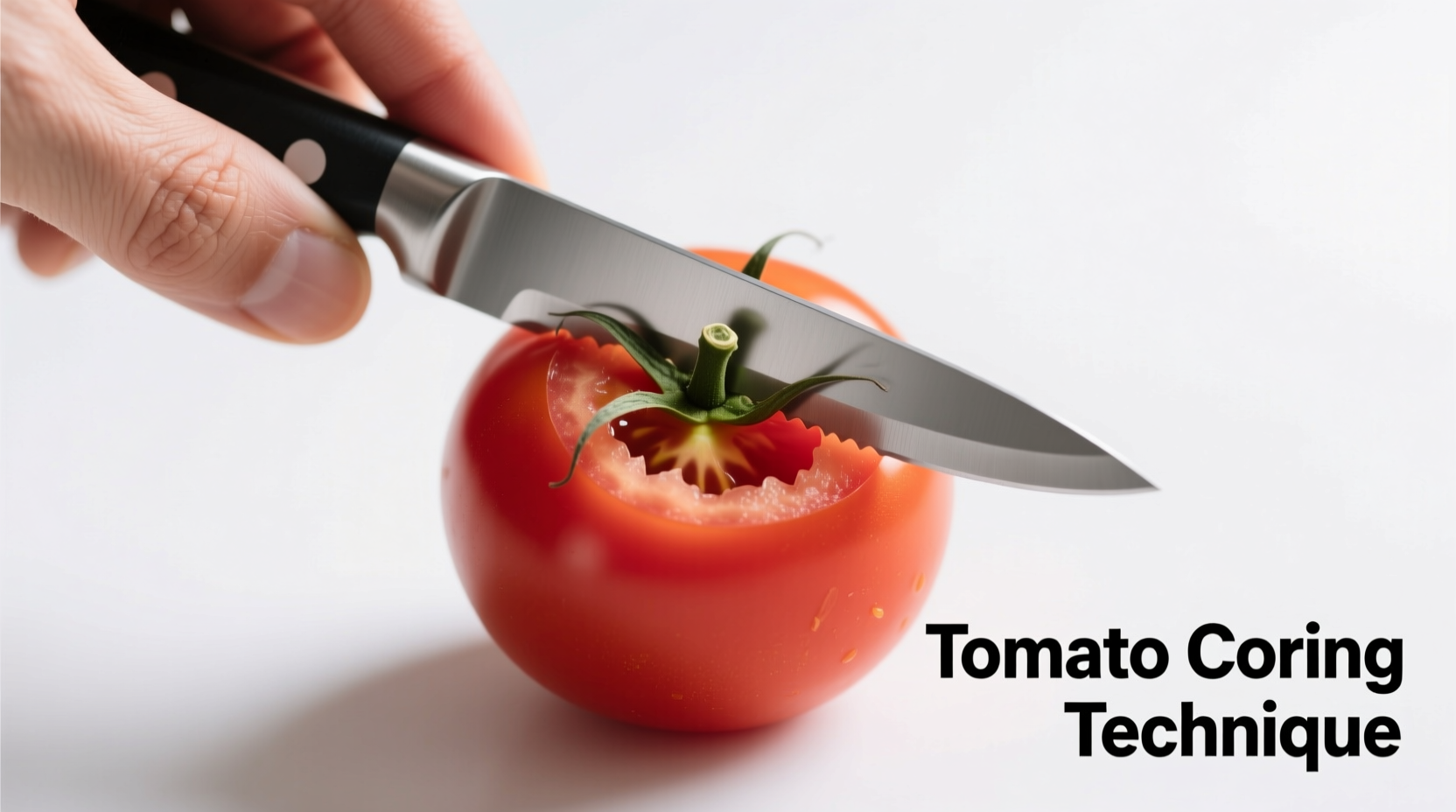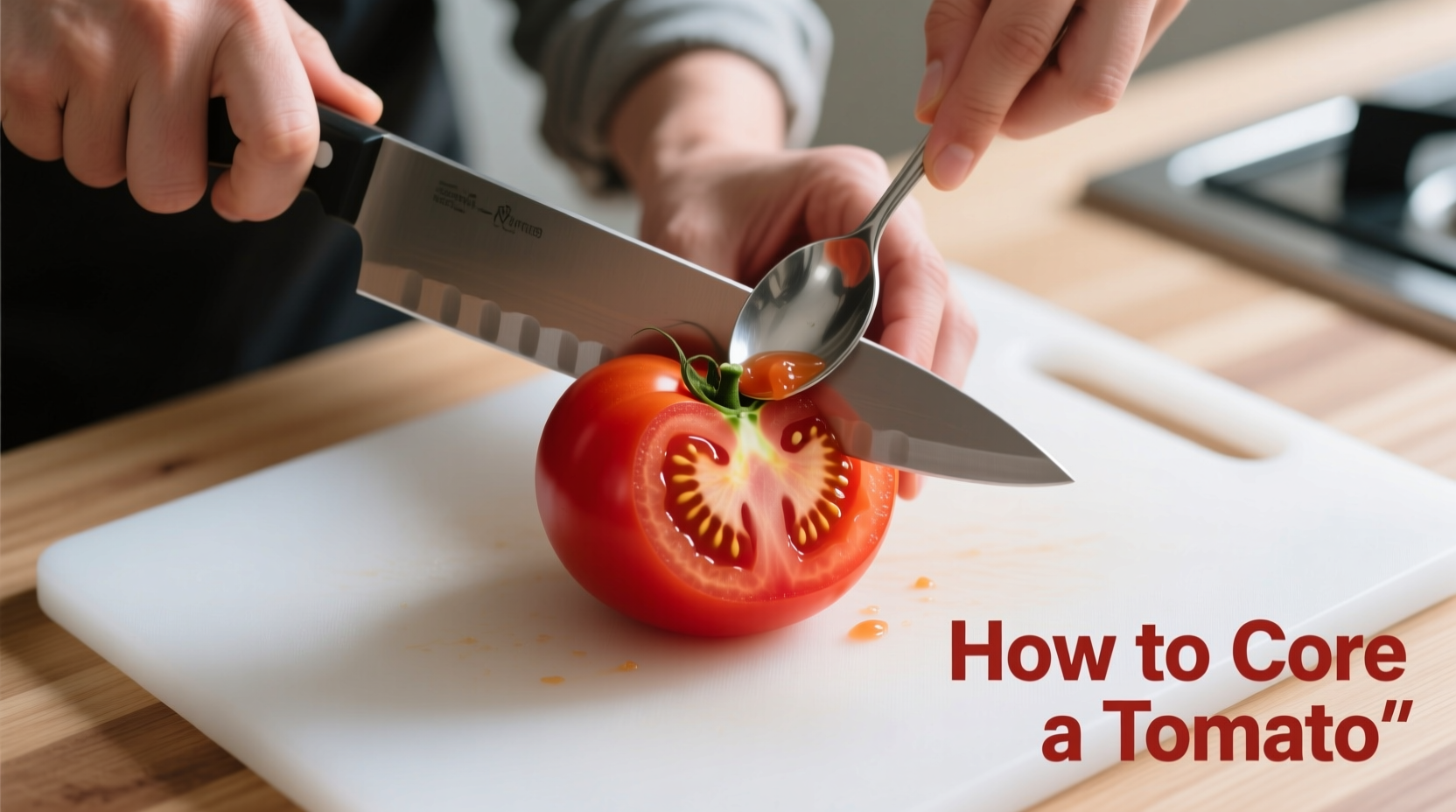Remove the tough central core of a tomato by inserting a paring knife at a 45-degree angle around the stem scar, then twisting and lifting out the core with the knife or a spoon. This technique works for all tomato varieties and takes less than 15 seconds per tomato.
Ever wondered why your tomato sauce turns out watery or your stuffed tomatoes collapse during cooking? The culprit is often the uncored tomato. Properly cored tomatoes yield better texture, flavor concentration, and structural integrity in dishes. As a professional chef with years of kitchen experience, I've found that mastering this simple technique transforms ordinary recipes into restaurant-quality creations.
Why Coring Matters for Cooking Success
Tomato cores contain the densest concentration of seeds and gel, which release excess liquid during cooking. According to USDA agricultural research, the central core accounts for approximately 15-20% of a tomato's total water content. When preparing sauces, soups, or stuffed dishes, this excess moisture dilutes flavors and creates texture issues. Professional kitchens universally core tomatoes before processing them for these applications.
| Application | Core Status | Result |
|---|---|---|
| Marinara sauce | Uncored | Watery consistency requiring extended reduction time |
| Marinara sauce | Cored | Richer flavor with proper texture in half the cooking time |
| Stuffed tomatoes | Uncored | Filling leaks, tomatoes collapse during baking |
| Stuffed tomatoes | Cored | Structural integrity maintained, even cooking |
Essential Tools for Perfect Tomato Coring
You don't need specialized equipment to core tomatoes effectively. Most home kitchens already have what's required:
- Paring knife (3-4 inch blade) - The most versatile option
- Tomato corer - Specialized tool for frequent use Soup spoon Ideal for larger tomatoes or when knife skills are limited
According to culinary research from America's Test Kitchen, a standard paring knife produces cleaner cuts with less flesh removal compared to specialized corers, making it the preferred tool for most home cooks.

Step-by-Step: The Professional Coring Technique
Follow these steps for perfect results every time, whether you're preparing tomatoes for canning, sauces, or stuffing:
- Prepare your workspace - Place tomato on cutting board with stem scar facing up
- Position your knife - Insert paring knife at 45-degree angle just outside the stem scar
- Cut around the core - Rotate tomato while maintaining consistent angle and depth
- Remove the core - Twist knife gently to loosen, then lift out core with knife tip or spoon
- Check for completeness - Ensure all seed pockets and tough central fibers are removed
Alternative Methods for Special Situations
Different tomato varieties and cooking applications sometimes require modified techniques:
For Large Beefsteak Tomatoes
When preparing stuffed tomatoes, use a small spoon after the initial knife cut to carefully scoop out additional seed pockets while preserving maximum structural integrity. This technique prevents collapse during baking while creating perfect space for fillings.
For Cherry or Grape Tomatoes
These small varieties require a different approach. Instead of coring, professional chefs recommend "topping" - slicing just the top quarter off where the stem attaches, then gently squeezing out seeds. This preserves more edible flesh while removing the toughest portion.
When Making Tomato Sauce
For sauce preparation, many home cooks ask "do you core tomatoes before making sauce?" The answer is absolutely yes. Uncored tomatoes introduce excess liquid and inconsistent texture. After coring, quarter tomatoes and remove any remaining seed pockets for the smoothest sauce possible. This professional technique reduces cooking time by up to 30% while concentrating flavor.
Avoid These Common Coring Mistakes
Even experienced cooks sometimes make these errors that compromise results:
- Incorrect angle - Cutting straight down instead of at 45 degrees removes too much edible flesh
- Insufficient depth - Not reaching deep enough leaves tough central fibers that affect texture
- Rushing the twist - Forcing the core out can tear surrounding flesh, creating uneven surfaces
- Using dull tools - A sharp knife creates clean cuts with minimal damage to surrounding tissue
Practical Applications for Your Next Recipe
Now that you know how to core tomatoes properly, here's how to apply this technique in real cooking situations:
For Canning Whole Tomatoes
Coring creates a clean opening for easy peeling while maintaining structural integrity during the canning process. The National Center for Home Food Preservation specifically recommends coring tomatoes before water bath canning to prevent air pockets and ensure proper seal formation.
For Fresh Salsas and Salads
While some recipes don't require coring, removing the central core from larger tomatoes significantly improves texture in fresh applications. The gel surrounding tomato seeds contains enzymes that can make dressings separate prematurely. For restaurant-quality salsas that maintain perfect consistency, always core before dicing.
Mastering Tomato Preparation for Better Results
Learning how to core a tomato properly represents one of those fundamental kitchen skills that separates amateur cooks from those who consistently produce professional results. This simple technique, taking mere seconds per tomato, dramatically improves the quality of sauces, soups, stuffed dishes, and preserved tomatoes. By understanding when and how to core tomatoes for different applications, you'll achieve better flavor concentration, improved texture, and more reliable cooking results every time.











 浙公网安备
33010002000092号
浙公网安备
33010002000092号 浙B2-20120091-4
浙B2-20120091-4